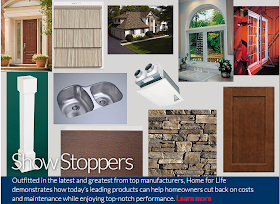Monday, November 24, 2014
Home For Life
Optimized for aging-in-place, the 2014 Home for Life offers a roadmap to creating beautiful, efficient homes that can comfortably adapt to every stage of life.
Every eight seconds someone in the United States turns 65—and odds are they want to stay in their home.
In January 2011, the first wave of the country’s nearly 80 million baby boomers officially reached retirement age—a group that will continue to grow by more than 10,000 a day for another 15 years. AARP surveys of those 50 and older have consistently found that this group overwhelmingly wants to stay put as long as possible, however most haven’t yet taken steps to ensure their home can continue to live comfortably as they age. The need for smart solutions that improve how homes function for every member of the family, regardless of age or ability, has never been greater—and that’s exactly what the 2014 Home for Life has to offer.
Created in collaboration with an all-star team of designers, universal design consultants, efficiency specialists, and professional organizations, this year’s Home for Life offers a revolutionary suite of ideas that enable homes to live better, last longer, and perform more efficiently.
Starting with a design based on a typical 1970s suburban home, the team at Case Design/Remodeling and the universal design experts at the Better Living Design Institute crafted a remodel that updates both the home’s aesthetic and functionality with innovative solutions tailored to meet the needs of today's boomers while making life easier on every member of the family.
The most common misconception about universal design, says Herman Johnson, senior architectural specialist at Case and one of the project’s designers, is that people often think of it as something useful only to those with limited mobility. “The spaces are not just about grab bars and wide hallways. Many universal design features are very subtle,” he says, pointing to thoughtful details like raised front-loading washers and dryers that make loading and unloading laundry easier on everyone.
“We’re really after the mainstream audience by adding features that blend in,” says Richard Duncan, executive director at Better Living Design. “Remodelers can bring clients features they’ll see in Home for Life that will work well and look great. They’ll be able to offer all these convenience and ease of use things everyone will like that also happen to work with them long term.”
The home’s performance also got an update with the latest in energy-efficient practices and cutting-edge products that not only cut down on energy consumption but can also improve indoor air quality and the health and safety of occupants. “It’s not just about energy-efficiency,” says Larry Zarker, CEO at the Building Performance Institute (BPI), which served as Home for Life’s high-performance guru. “It’s also about addressing health concerns, such as asthma triggers found in the home, and safety issues including preventing gas and carbon monoxide leaks.” Efficiency improvements also help ensure all rooms are comfortable and free of drafts, while reducing monthly energy bills.
The result is a design filled with ideas as beautiful and functional as they are adaptable. Remodelers and homeowners can use the design as a template for their own project, or pick and choose the best practices that fit their needs as they create their own home for life.
This post is featured from The Home For Life Project 2014




Pretty good post. I just stumbled upon your blog and wanted to say that I have really enjoyed reading your blog posts.
ReplyDeleteReplacement Patio Door Glass
Windows And Doors Las Vegas
Modern Entry Doors
Sliding Door Replacement